1993 BUICK CENTURY wheel
[x] Cancel search: wheelPage 79 of 324
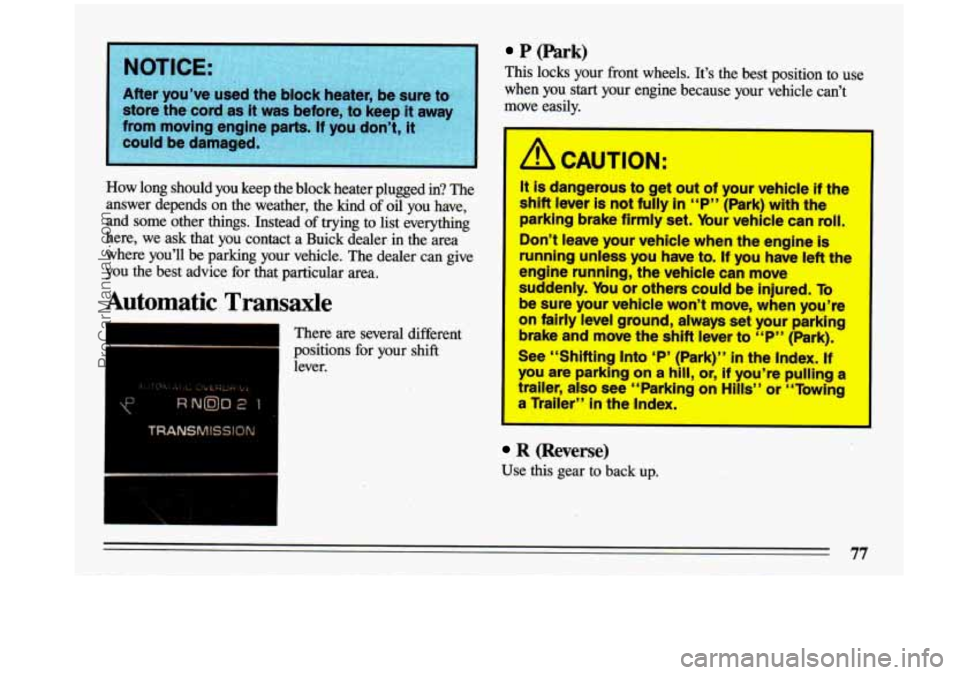
NOTICE:
After you’ve
How long should you keep the block heater plugged in? The
answer depends on the weather, the kind of
oil you have,
and some other things. Instead of trying
to list everything
here, we ask that you contact a Buick dealer, in the area
where you’ll be parking your vehicle. The dealer can give
you the best advice for that particular area.
Automatic .Transaxle
There are several different
positions for your
shift
lever.
P (Park)
This locks your front wheels. It’s the best position to use\
when you
start your engine because your vehicle can’t
move easily.
I- -
I a CAUTION:
It is dangerous to get out of your vehicle if the
shift lever is
not fully in “P” (Park) with the
parking brake firmly set.
Your vehicle can roll.
Don’t leave your vehicle when the engine is
running unless you have to. If you have left the
engine running, the vehicle can move
suddenly. You
or others could be injured. To I
be sure your vehicle won’t move, when you’re
on fairly level
ground, always set your parking
brake and move the shift lever to “P” (Park).
See “Shifting
Into ‘P’ (Park)” in the Index. If
you are parking
on a hill, or, if you’re pulling a
trailer, also see “Parking
on Hills” or “Towing
a Trailer”
in the Index.
R (Reverse)
Use this gear to back up.
ProCarManuals.com
Page 80 of 324

f, ‘,,moving forward could damage your transaxle,
to
“R” only after your vehicle is stopped
To rock your vehicle back and forth to get out of snow,
ice or sand without damaging your transaxle, see “If
You’re
Stuck: In Sand, Mud, Ice or Snow’’ in the Index.
N (Neutral)
In this position, your engine doesn’t connect with the
wheels.
To restart when you’re already moving, use
“N” (Neutral)
only. Also, use “N” when your vehicle is
being towed.
I A CAUTION:
Shifting out,of “P” (Park) or “N” (Neutral)
while your engine is “racing” (running at high
speed) is dangerous. Unless your foot is firmly
on the brake pedal, your vehicle could move
very rapidly. You could lose control and
hit
people or objects. Don’t shift out of “P” (Park)
or “N” (Neutral) while your engine
is racing.
@ (Automatic Overdrive)
If your automatic transaxle has automatic overdrive, this
position is for normal driving. If you need more power
for passing,
and you’re:
- Going less than about 35 mph (56 km/h), push your
- Going about 35 mph (56 km/h) or more, push the
accelerator pedal about halfway down.
accelerator all the way down. You’ll
shift down to the
next gear and have more power.
D (Third Gear)
If your automatic transaxle does not have Overdrive, this
position is for normal driving, at all
speeds, in most
street
and highway situations.
78
ProCarManuals.com
Page 82 of 324
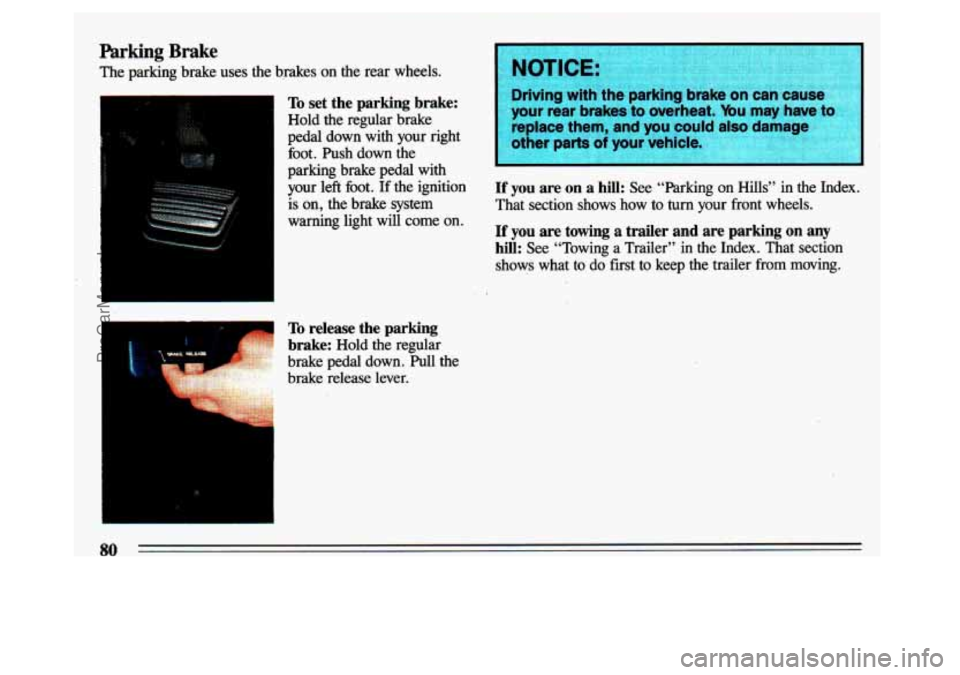
Parking Brake
The parking brake uses the brakes on the rear wheels.
I
To set the parking brake:
Hold the regular brake
pedal down with your right
foot. Push down the
parking brake pedal with
your left foot.
If the ignition
is on, the brake system
I warning light will come on.
L
I
To release the parking
brake:
Hold the regular
brake pedal down. Pull the
brake release lever.
NOTICE:
Driving with thiparl ‘g brake or )use
your rear brakesto oveFheat. ybu may have
-
replace them, and you could alse damage
other parts
of your vehicle.
If you are on a hill: See “Parking on Hills” in the Index.
That section shows
how to turn your front wheels.
If you are towing a trailer and are parking on any
hill: See “Towing a Trailer” in the Index. That section
shows what to do first to keep the trailer from
moving.
80
ProCarManuals.com
Page 88 of 324

Horn
You can sound the horn by pressing the horn symbol on
your steering wheel.
Tilt Steering Wheel (Option)
b
-.
A tilt steering wheel allows
you
to adjust the steering
wheel before you drive. You
can
also raise it to the
highest level
to give your
legs more room when you
exit and enter the vehicle.
To tilt the wheel, hold the
steering wheel and pull the
lever. Move the steering
wheel to a comfortable
level, then release the lever
to lock the wheel in place.
The I’urn SignaUHeadlight Beam
Lever
The lever on the left side of the steering column includes
your:
Turn Signal and Lane Change Indicator
Headlight High-Low Beam
Windshield Wipers
Windshield Washer
Cruise Control (Option)
86
ProCarManuals.com
Page 93 of 324
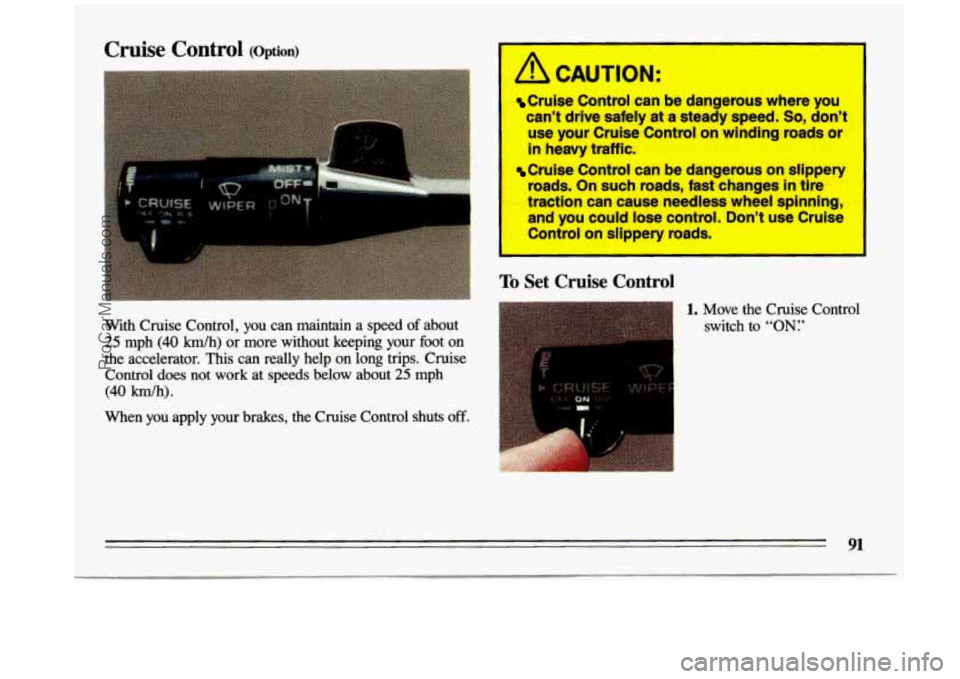
Cruise Control (option)
. .
- ~ "IWC.
. .. -
With Cruise Control, you can maintain a speed of about
25 mph (40 Wh) or more without keeping your foot on
the accelerator.
This can really help on long trips. Cruise
Control does not
work at speeds below about 25 mph
(40 Wh).
When you apply your brakes, the Cruise Control shuts
off.
A CAUTION:
Cruise Control can be dangerous where you
can't drive safely
at a steady speed. So, don't
use your Cruise Control on winding roads or
in heavy traffic.
Cruise Control can be dangerous on slippery
roads.
On such roads, fast changes in tire
traction can cause needless wheel spinning,
and you could lose control. Don't use Cruise
Control on slippery roads.
To Set Cruise Control
1. Move the Cruise Control
switch
to "ON?
91
ProCarManuals.com
Page 151 of 324
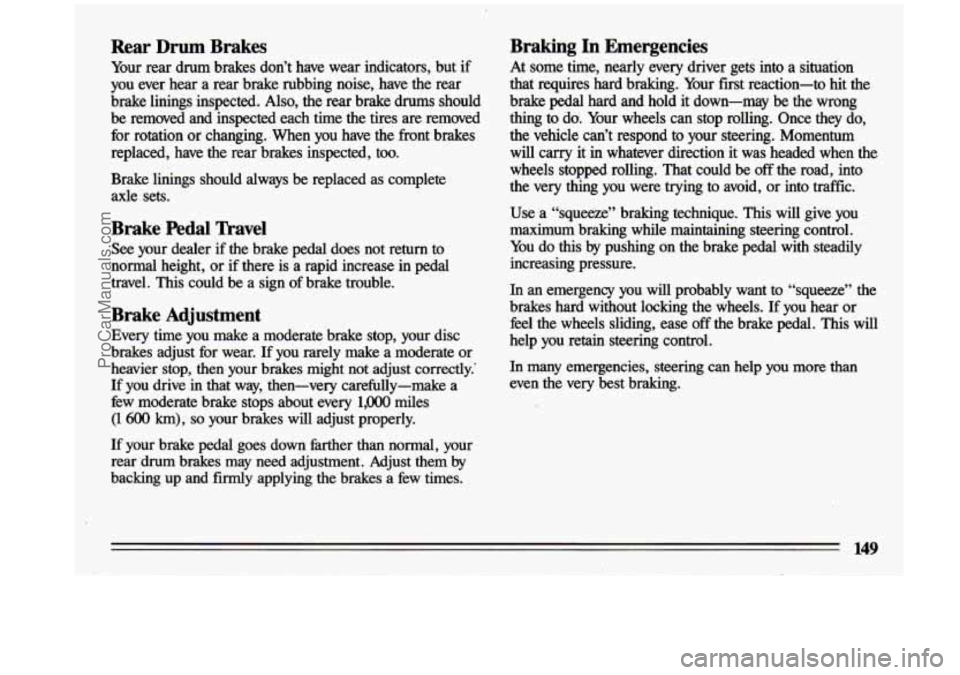
Rear Drum Brakes
Your rear drum brakes don’t have wear indicators, but if
you ever hear a rear brake rubbing noise, have the rear
brake linings inspected.
Also, the rear brake drums should
be removed and inspected each time the tires are removed
for rotation or changing. .When you have the front brakes
replaced, have the rear brakes inspected, too.
Brake linings should always be replaced as complete
axle sets.
Braking In Emergencies
At some time, nearly every driver gets into a situation
that requires hard braking. Your first reaction-to
hit the
brake
pedal hard and hold it down-may be the wrong
thing to do. Your wheels can stop rolling. Once they
do,
the vehicle can’t respond to your steering. Momentum
will carry it
in whatever direction it was headed when the
wheels stopped rolling. That could be
off the road, into
the very thing you were trying
to avoid, or into traffic.
Use a “squeeze” braking technique. This will give you
maximum braking while maintaining steering control.
You do
this by pushing on the brake pedal with steadily
increasing pressure.
Brake Pedal Travel
See your dealer if the brake pedal does not return to
normal height, or if there is a rapid increase in
pedal
travel. This could be a sign of brake trouble.
Brake Adjustment
Every time you make a moderate brake stop, your disc
brakes adjust for wear.
If you rarely make a moderate or
heavier stop, then your brakes might not adjust correctly.’
If you drive in that way, then-very carefully-make a
few moderate brake stops about every
1,0oO miles
(1 600 km), so your brakes will adjust properly.
If your brake pedal goes down farther than normal, your rear drum brakes may need adjustment. Adjust them by
backing up and
firmly applying the brakes a few times. In an emergency you will probably want
to “squeeze”
the
brakes hard without locking the wheels.
If you hear or
feel the wheels sliding, ease off the brake pedal. This will
help you retain steering control.
In many emergencies, steering can help you more than
even the very best braking.
149
ProCarManuals.com
Page 152 of 324
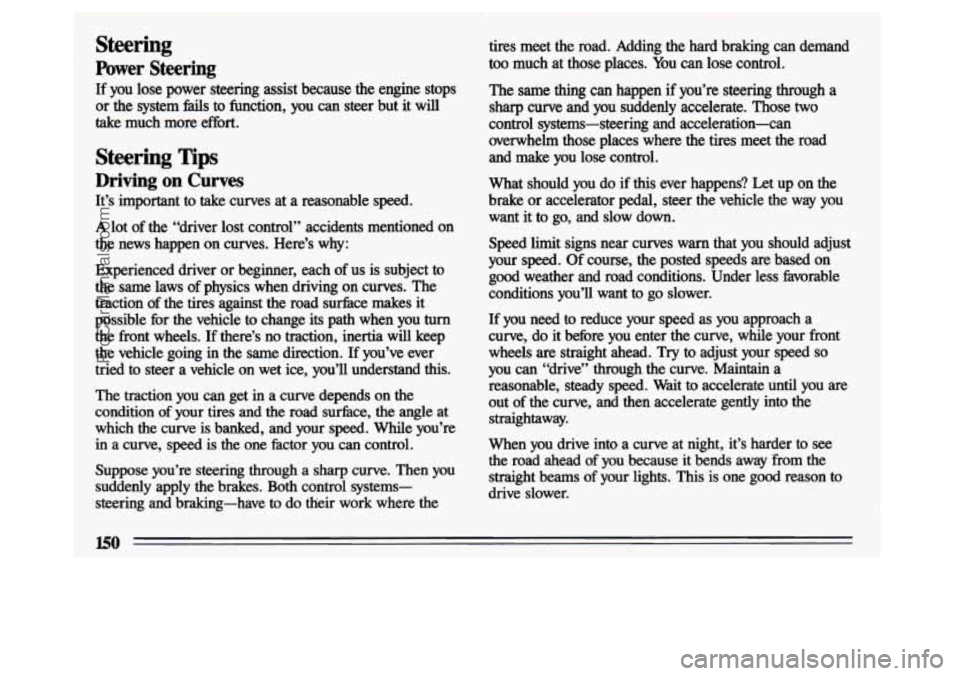
Steering
Power Steering
If you lose power steering assist because the engine stops
or the system
fails to function, you can steer but it will
take much more effort.
Steering Tips
Driving on Curves
It’s important to take curves at a reasonable speed.
A lot of the “driver lost control” accidents mentioned on
the news happen on curves. Here’s why:
Experienced driver or beginner, each of us is subject to
the same laws of physics when driving on curves. The
traction
of the tires against the road surface makes it
possible for the vehicle to change its path when you turn
the front wheels. If there’s no traction, inertia will keep
the vehicle going
in the same direction. If you’ve ever
tried to steer a vehicle on wet ice, you’ll understand
this.
The traction you can get in a curve depends on the
condition
of your tires and the road surhce, the angle at
which the curve is banked, and your
speed. While you’re
in a curve, speed is the one factor you can control.
Suppose you’re steering through
a sharp curve. Then you
suddenly apply
the brakes. Both control systems-
steering and braking-have
to do their work where the
tires meet the road. Adding the hard braking can demand
too much at those places. You can lose control.
The
same thing can happen if you’re steering through a’
sharp curve and you suddenly accelerate. Those two
control systems-steering and acceleration-can
overwhelm those places where the tires meet the road and make you lose ‘control.
What should you do
if this ever happens? Let up on the
brake or accelerator
pedal, steer the vehicle the way you
want it to go, and slow down.
Speed limit signs near curves warn that you should adjust
your
speed. Of course, the posted speeds are based on
good weather and road conditions. Under less favorable
conditions you’ll want
to go slower.
If you need to reduce your speed as you approach a
curve, do it before you enter the curve, while your front
wheels
are straight ahead. Try to adjust your speed so
you can “drive” through the curve. Maintain a
reasonable, steady speed. Wait to accelerate until you are
out of the curve, and then accelerate gently into the
straightaway.
When you drive
into a curve at night, it’s harder to see
the road ahead of you because it bends away .from the
straight beams of your lights.
This is one good reason to
drive slower.
ProCarManuals.com
Page 153 of 324

Steering in Emergencies
There are times when steering can be more effective than
braking. For example, you come over a hill and find a
truck stopped in your lane, or a car suddenly pulls out
from nowhere, or a child darts out from between parked
cars and stops right in front of you. You can avoid these
problems
by braking-if you can stop in time. But
sometimes you can’t; there isn’t room. That’s the time for
evasive action-steering around the problem. Your Buick
can perform very well in emergencies like
these. First apply your brakes, but not enough to lock
your wheels.
It is better to remove as much speed as you
can from a possible collision. Then steer around the
problem, to the
left or right depending on the space
available.
An emergency like this requires close attention and a
quick decision. If you are holding the steering wheel at
the recommended
9’ and 3 o’clock positions, you can turn
it a full
180 degrees very quickly without removing either
hand. But you have to act fast, steer quickly, and just as
quickly straighten the wheel once you have avoided the
object. You must then be prepared to steer back to your
original lane and then brake to
a controlled stop.
Depending on your speed,
this can be rather violent for
an unprepared driver. This is one of the reasons driving
experts recommend that you use your safety belts and
keep both hands on the steering wheel.
The fact that such emergency situations are always
possible is a good reason to practice defensive driving at all times.
151
ProCarManuals.com